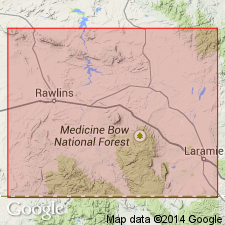
- Usage in publication:
-
- Allen Ridge formation
- Modifications:
-
- Original reference
- Dominant lithology:
-
- Sandstone
- Shale
- AAPG geologic province:
-
- Green River basin
Summary:
Pg. 114 (generalized composite strat. section). Allen Ridge formation of Mesaverde group. Comprises (ascending) about 550 feet of ripple-marked sandstones alternating with thicker carbonaceous shales and coaly beds; more than 550 feet of light-brown sandstones, generally 5 to 20 feet thick, separated by very poorly consolidated sandy shales and shaly sandstones which contain a few carbonaceous units; and 80 feet primarily of gray to gray-blue soft noncalcareous shale. Total thickness of formation 1,200 feet. Underlies Pine Ridge sandstone; overlies Steele formation. [Age is Late Cretaceous.]
Type section (composite): from sec. 9, T. 22 N., R. 79 W., and sec. 18, T. 23 N., R. 79 W., [Como East 7.5-min quadrangle], Carbon Co., south-central WY.
Apparently named from ridge adjacent to Allen Station [now abandoned] on the Union Pacific RR [in S/2 SW/4 sec. 10, T. 22 N., R. 79 W., approx. Lat. 41 deg. 53 min. 13 sec. N., Long. 106 deg. 16 min. 55 sec. W., Saddleback Hills 15-min quadrangle (1914; 1921 ed.)], Carbon Co., south-central WY.
[Additional locality information from USGS GNIS database, Univ. Texas-Austin Perry-Castaneda Library historical map collection, Montana State Univ. Graphical Locator, ACME Mapper 2.0; accessed November 29, 2011.]
Source: US geologic names lexicon (USGS Bull. 1200, p. 57).

- Usage in publication:
-
- Allen Ridge Formation*
- Modifications:
-
- Principal reference
- Adopted
- Dominant lithology:
-
- Sandstone
- Shale
- AAPG geologic province:
-
- Green River basin
Summary:
Pg. 6 (table 1), 24-29. Allen Ridge Formation of Mesaverde Group. Consists of (ascending): (1) lower nonmarine unit of fluviatile sandstone, shale, and carbonaceous beds, about 685 feet thick; (2) middle marine unit of shale and sandstone, 195 feet thick; and (3) upper brackish-water unit of shale, 375 feet thick. Total thickness 1,255 feet at principal reference section. Conformably overlies Haystack Mountains Formation; underlies, with probably unconformity, Pine Ridge Sandstone. Equivalent to Rock River Formation of western Powder River basin and Iles Formation of Mesaverde Group of northwestern Colorado. Fossiliferous. Age is Late Cretaceous (late Cenomanian; BACULITES PERPLEXUS to DIDYMOCERAS NEBRASCENSE Western Interior ammonite zones) based on stratigraphic position.
Principal reference section: along north and south sides of Pine Tree Gulch [now Pine Draw], in S/2 NE/4 sec. 19, T. 23 N., R. 79 W., [about 7.5 mi northwest of Medicine Bow, approx. Lat. 41 deg. 57 min. 10 sec. N., Long. 106 deg. 19 min. 50 sec. W., Como East 7.5-min quadrangle], Carbon Co., south-central WY. [Authors unable to recover Bergstrom's composite type section.]
[Additional locality information from USGS GNIS database, Montana State Univ. Graphical Locator, ACME Mapper 2.0; accessed November 29, 2011.]
Source: Publication.
For more information, please contact Nancy Stamm, Geologic Names Committee Secretary.
Asterisk (*) indicates published by U.S. Geological Survey authors.
"No current usage" (†) implies that a name has been abandoned or has fallen into disuse. Former usage and, if known, replacement name given in parentheses ( ).
Slash (/) indicates name conflicts with nomenclatural guidelines (CSN, 1933; ACSN, 1961, 1970; NACSN, 1983, 2005, 2021). May be explained within brackets ([ ]).

